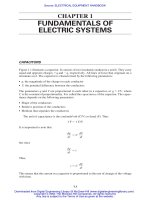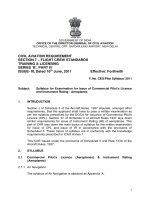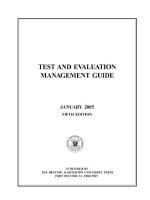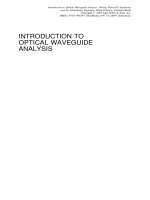Electrician's troubleshooting and testing pocket guide
Bạn đang xem bản rút gọn của tài liệu. Xem và tải ngay bản đầy đủ của tài liệu tại đây (3.12 MB, 241 trang )
Electrician’s
Troubleshooting
and Testing
Pocket Guide
ABOUT THE AUTHORS
H. Brooke Stauffer is Executive Director of Standards
and Safety for the National Electrical Contractors
Association (NECA) in Bethesda, Maryland. He is
responsible for developing and publishing the
National Electrical Installation Standards (NEIS), a
series of ANSI-approved best practices for electrical
construction and maintenance work. He also has
written a number of electrical books, including
Residential Wiring for the Trades (McGraw-Hill, 2006).
Mr. Stauffer has been a member of three different
National Electrical Code-Making Panels (CMPs).
John E. Traister (deceased) was involved in the elec-
trical construction industry for more than 35 years.
He authored or co-authored numerous McGraw-Hill
books for electrical professionals, including Illustrated
Dictionary for Electrical Workers, Electrician’s Exam
Preparation Guide, and Handbook of Electrical Design
Details.
Copyright © 2007, 2000, 1996 by The McGraw-Hill Companies, Inc.
Click here for terms of use.
Electrician’s
Troubleshooting
and Testing
Pocket Guide
Third Edition
H. Brooke Stauffer
John E. Traister
McGraw-Hill
New York Chicago San Francisco Lisbon London Madrid
Mexico City Milan New Delhi San Juan Seoul
Singapore Sydney Toronto
Copyright © 2007, 2000, 1996 by The McGraw-Hill Companies, Inc. All rights reserved.
Manufactured in the United States of America. Except as permitted under the United
States Copyright Act of 1976, no part of this publication may be reproduced or distrib-
uted in any form or by any means, or stored in a database or retrieval system, without the
prior written permission of the publisher.
0-07-150929-1
The material in this eBook also appears in the print version of this title: 0-07-148782-4.
All trademarks are trademarks of their respective owners. Rather than put a trademark
symbol after every occurrence of a trademarked name, we use names in an editorial fash-
ion only, and to the benefit of the trademark owner, with no intention of infringement of
the trademark. Where such designations appear in this book, they have been printed with
initial caps.
McGraw-Hill eBooks are available at special quantity discounts to use as premiums and
sales promotions, or for use in corporate training programs. For more information, please
contact George Hoare, Special Sales, at or (212)
904-4069.
TERMS OF USE
This is a copyrighted work and The McGraw-Hill Companies, Inc. (“McGraw-Hill”) and
its licensors reserve all rights in and to the work. Use of this work is subject to these
terms. Except as permitted under the Copyright Act of 1976 and the right to store and
retrieve one copy of the work, you may not decompile, disassemble, reverse engineer,
reproduce, modify, create derivative works based upon, transmit, distribute, disseminate,
sell, publish or sublicense the work or any part of it without McGraw-Hill’s prior consent.
You may use the work for your own noncommercial and personal use; any other use of
the work is strictly prohibited. Your right to use the work may be terminated if you fail to
comply with these terms.
THE WORK IS PROVIDED “AS IS.” McGRAW-HILL AND ITS LICENSORS MAKE
NO GUARANTEES OR WARRANTIES AS TO THE ACCURACY, ADEQUACY OR
COMPLETENESS OF OR RESULTS TO BE OBTAINED FROM USING THE WORK,
INCLUDING ANY INFORMATION THAT CAN BE ACCESSED THROUGH THE
WORK VIA HYPERLINK OR OTHERWISE, AND EXPRESSLY DISCLAIM ANY
WARRANTY, EXPRESS OR IMPLIED, INCLUDING BUT NOT LIMITED TO
IMPLIED WARRANTIES OF MERCHANTABILITY OR FITNESS FOR A PARTIC-
ULAR PURPOSE. McGraw-Hill and its licensors do not warrant or guarantee that the
functions contained in the work will meet your requirements or that its operation will be
uninterrupted or error free. Neither McGraw-Hill nor its licensors shall be liable to you
or anyone else for any inaccuracy, error or omission, regardless of cause, in the work or
for any damages resulting therefrom. McGraw-Hill has no responsibility for the content
of any information accessed through the work. Under no circumstances shall
McGraw-Hill and/or its licensors be liable for any indirect, incidental, special, punitive,
consequential or similar damages that result from the use of or inability to use the work,
even if any of them has been advised of the possibility of such damages. This limitation
of liability shall apply to any claim or cause whatsoever whether such claim or cause
arises in contract, tort or otherwise.
DOI: 10.1036/0071487824
v
CONTENTS
Introduction vii
1 Analog Test Instruments 1
2 Digital Multimeters 25
3 Troubleshooting Basics 39
4 Troubleshooting Dry-Type
Transformers 49
5 Troubleshooting Luminaires
(Lighting Fixtures) 57
6 Troubleshooting Electric
Motors 91
7 Troubleshooting Motor Bearings 159
8 Troubleshooting Relays and
Contactors 175
9 Troubleshooting Power Quality
Problems 191
10 Troubleshooting with Infrared
Thermography 209
Index 213
For more information about this title, click here
ebooksdownloadrace.blogspot.in
This page intentionally left blank
Introduction
E
lectrical measuring and testing instruments are used
in the installation, troubleshooting, and mainte-
nance of electrical systems of all types, particularly in
commercial and industrial facilities. Electricians and
technicians involved with installing, maintaining, and
repairing electrical equipment need a good working
knowledge of portable testing instruments and how
they are used to diagnose and fix problems in the field.
Most operational problems of electrical equipment
and systems involve one of four basic faults:
● Short circuit
● Ground fault
● Open circuit
● Change in electrical value
This guide describes troubleshooting techniques to
identify such problems using portable field-testing
instruments. Although it covers many types of test
equipment, this book emphasizes the use of digital
multimeters (DMMs), the most common and versatile
electrician’s diagnostic tool.
This new third edition of Electrician’s Troubleshooting
and Testing Pocket Guide includes updated information
vii
Copyright © 2007, 2000, 1996 by The McGraw-Hill Companies, Inc.
Click here for terms of use.
on testing and troubleshooting lighting systems,
expanded information on diagnosing power quality
problems, and a new chapter on thermographic diag-
nostic tools.
Scope of This Book
Electrician’s Troubleshooting and Testing Pocket Guide
covers the use of digital multimeters (DMMs) and
other testing equipment to troubleshoot electrical
and electronic circuits used for power and control
applications. In general, it concentrates on traditional
electromechanical and inductive equipment found in
commercial and industrial occupancies—motors,
transformers, lighting, and power distribution equip-
ment. In general, this guide does not cover testing
and troubleshooting of the following types of equip-
ment and systems:
Communications systems. The use of network
cable analyzers, optical time domain reflectometers
(OTDRs), optical power meters, and other equipment
used for testing and troubleshooting communica-
tions systems such as telecommunications, com-
puter local area networks (LANs), and outside plant
fiber-optic installations are outside the scope of this
publication.
Electronic components and systems. This book
touches on testing of electronic components such as
resistors, small capacitors, and diodes. However, the
broad subject of troubleshooting electronic compo-
nents and circuits using digital multimeters and other
viii
portable test equipment is covered in much greater
detail in a different McGraw-Hill publication:
Electronic Troubleshooting and Repair Handbook by
Homer L. Davidson (1995; ISBN 0-07-015676-X).
H. Brooke Stauffer
Executive Director of Standards and Safety
National Electrical Contractors Association (NECA)
Bethesda, Maryland
ix
This page intentionally left blank
Electrician’s
Troubleshooting
and Testing
Pocket Guide
This page intentionally left blank
We hope you enjoy this
McGraw-Hill eBook! If
you’d like more information about this book,
its author, or related books and websites,
please
click here.
Professional
Want to learn more?
CHAPTER
1
Analog Test Instruments
T
raditional meters used by electricians and techni-
cians for field testing and troubleshooting are ana-
log type. In an analog meter, the magnitude of the
property being measured (such as voltage, current,
resistance, and illumination) is indicated by a corre-
sponding physical movement of a pointer, needle, or
other indicator. Voltage, for example, is shown by the
needle of a traditional voltmeter swinging to point at
a number on a dial.
Analog meters are generally limited to a single
function. The most common types are ammeters,
voltmeters, and resistance testers (frequently called
meggers in the field, after the name of one of the best-
known brands of resistance tester). In some cases the
usefulness of traditional analog electrical test instru-
ments can be extended or modified with special adap-
tors or sensors; some voltmeters, for example, can also
be used to measure temperature.
Today, the different types of single-function analog
meters have been largely replaced by digital (comput-
erized) meters that combine many measurement
functions within a single compact unit. These digital
multimeters (DMMs) are now used for most testing,
1
Copyright © 2007, 2000, 1996 by The McGraw-Hill Companies, Inc.
Click here for terms of use.
troubleshooting, and maintenance purposes. However,
there are still many older analog meters in use, and a
working knowledge of these diagnostic tools is useful
to electricians and technicians.
This chapter briefly describes the various types of
analog electrical meters and instruments, and how
they are used. Starting with Chapter 2, the rest of the
handbook concentrates primarily on using DMMs.
Ammeters
Figure 1-1 shows a clamp-on ammeter used to mea-
sure current in a conductor while the conductor is
energized. While exact operating procedures vary
with the manufacturer, most operate as follows when
measuring current:
2
1-1 Typical clamp-on-type ammeter.
Step 1. Release the pointer lock.
Step 2. Turn the selector knob until the highest
current range appears in the scale window.
Step 3. Press the trigger to open the jaws of the
clamp and place them around a single
conductor.
Step 4. Release finger pressure on the trigger
slowly, keeping an eye on the scale while
the jaws close around the conductor. If
the pointer jumps abruptly to the upper
range of the scale before the jaws are
completely closed, the current is too high
for the scale selected. Immediately remove
the jaws from around the conductor, and
use a higher scale.
Never encircle two or more conductors; only encir-
cle one conductor as shown in Figure 1-1. If the
pointer moves normally, close the jaws completely
and read the current in amperes indicated on the scale.
Accuracy
When using clamp-on ammeters, follow these precau-
tions to obtain accurate readings:
1. Be certain the frequency of the conductor
being tested is within the range of the instru-
ment. Most ammeters are calibrated at 70 Hz.
2. Magnetic fields can affect current readings.
To minimize this problem, try to avoid using
3
clamp-on ammeters close to transformers,
motors, relays, and contactors.
Ammeter Applications
Ammeters are useful for troubleshooting various elec-
trical components by indicating a change in electrical
value. Many examples and troubleshooting charts
found throughout this book. But here are two simple
examples of ammeter applications.
Three-phase motor
The approximate load on a three-phase motor can be
determined while the motor is running. To do this,
clamp the ammeter around each of the three-phase
conductors, one by one:
●
If the ammeter shows the motor is draw-
ing current close to its nameplate reading,
this indicates the motor is fully loaded.
●
If the ampere reading on each conductor
is significantly less, then the motor is not
carrying a full load.
●
If the current measured with the amme-
ter is higher than the nameplate, when
the motor is running at full speed and
rated voltage, then the motor can be
assumed to be overloaded.
Electric baseboard heater
The nameplate will indicate the heater’s characteristics.
Let’s assume that the nameplate indicates a 1000-W,
single-phase, two-wire heating element operating at
240 A. If an ammeter reading, which is taken while the
4
heater is operating, shows approximately 4 A of current,
this indicates the heater is working properly, because:
I ϭ
p
E
or
1000
240
ϭ 4.16 A
But an ampere reading much different from 4 A
(either higher or lower) indicates some fault in either
the heater or the branch circuit supplying it.
Recording Ammeters
A clamp-on ammeter shows instantaneous current, at
a moment in time. But often when troubleshooting
electrical equipment and systems, it is more useful
to have a record of current over a period of time.
Figure 1-2 shows a recording ammeter used for this
5
1-2 Recording ammeter.
purpose. It has a current-sensing element similar to
clamp-on ammeters, but produces a chart or graph
showing current changes over time.
Voltmeters
The unit of electromotive force (EMF) is the volt (V).
One volt is the pressure that, if applied to an electri-
cal circuit having a resistance of 1 Ω, produces a cur-
rent of 1 A.
Connect a voltmeter across the terminals at the
place where the voltage is to be measured, as shown
in Figure 1-3. Never connect a voltmeter across a cir-
cuit with a voltage higher than the rating of the
instrument. Doing so can damage the meter, or in
extreme cases cause the voltmeter to explode.
DC Circuits
When measuring voltage in a DC circuit, always
observe proper polarity. The negative lead of the volt-
meter must be connected to the negative terminal of
the DC source, and the positive lead to the positive
6
1-3 Connecting a voltmeter
to a circuit.
terminal. If the leads are connected to opposite ter-
minals, the needle will move in the reverse direction.
AC Circuits
Since voltage constantly reverses polarity in an AC cir-
cuit, there is no need to observe polarity when mea-
suring voltage on ac circuits (Figure 1-4).
Voltage Ranges
Many analog voltmeters have two or more voltage
ranges that can be read on a common scale, such as 0 to
150 V, 0 to 300 V, and 0 to 600 V (Figure 1-5). When
using a multirange voltmeter, always select a higher
range than needed to assure that the meter won’t be
damaged. Then, if the initial reading indicates that a
lower scale is needed to obtain a more accurate read-
ing, switch the voltmeter to the next lowest range.
7
1-4 Checking voltage at a 125-VAC duplex
receptacle.
ebooksdownloadrace.blogspot.in
One reason that analog voltmeters have multiple
ranges is that readings are more accurate on the upper
half of the scale. Thus, if they only had a single 0- to
600-V range, lower voltages would be harder to read
accurately.
Voltmeter Applications
Voltmeters are used for troubleshooting circuits,
circuit tracing, and measuring low resistance. For
example, a common cause of electrical problems is
low voltage at the supply terminals of equipment; this
usually occurs for one or more of the following
reasons:
●
Undersized conductors
●
Overloaded circuits
●
Transformer taps set too low
8
1-5 Multirange, one-scale voltmeter.
Low-Voltage Test
When making a low-voltage test, first take a reading
at the service entrance. For example, if the main ser-
vice is rated 120/240, single-phase, three-wire, the
voltage reading between phases (ungrounded conduc-
tors) should be 230 to 240 V. If the reading is much
lower than 230 V, the electric utility company should
be contacted to correct the problem. However, if the
reading at the main service is between 230 and 240 V,
the next procedure is to check the voltage reading at
various outlets throughout the system.
When low-voltage problem is measured on a cir-
cuit, leave the voltmeter terminals connected across
the line and begin disconnecting all the loads con-
nected to that circuit, one at a time. If the problem
disappears after several of the loads have been discon-
nected, the circuit is probably overloaded (thus caus-
ing excessive voltage drop). Steps should be taken to
reduce the load on that circuit or else increase con-
ductor wire size to accommodate the load.
Ground Fault
Ground faults are another common problem. Assume
that a small industrial plant has a three-phase, three-
wire, 240-V, delta-connected service. The service
equipment is installed, as shown in Figure 1-6. Under
proper operating conditions, the voltmeter should
read 240 V between phases (A-B, B-C, and A-C), and
approximately 150 V between each phase to ground.
However, if checking with voltmeter indicates that
two phases have a voltage of 230 V to ground and the
9
third phase is only 50 V to ground, then the phase
with the lowest reading (50 V) has a partial ground or
ground fault. Follow these steps to correct the ground
fault:
Step 1. Connect one voltmeter lead to the
grounded enclosure of the main distribu-
tion panel and the other to the phase ter-
minal that indicated the ground fault.
Step 2. Disconnect switch A and check the volt-
meter reading. If no change is indicated,
disconnect switch B, switch C, and so on,
until the voltmeter shows a change (i.e.,
a reading of approximately 150 V from
phase to ground).
Step 3. Assuming the voltmeter indicates this
reading when switch D is thrown to the
10
1-6 Diagram of a small industrial electric service.
OFF position, we then know that the
ground fault is located somewhere on
this circuit.
Step 4. Switch D disconnects the 400-A circuit
feeding eight 15-hp motors and con-
nected as shown in Figure 1-7. One volt-
meter lead is connected to the grounded
housing of switch D and the other lead
to one of the phase terminals. The switch
is then turned on. Check each phase ter-
minal until the one with the ground
fault is located.
Step 5. Then, one at a time, disconnect the motors
from the circuit until the one causing the
trouble is found. In other words, when the
motor or motor circuit with the ground
fault is disconnected, the voltmeter will
indicate a normal voltage of approximately
150 V from phase to ground.
11
1-7 Wiring diagram for eight 15-hp pump motors
fed from a 400-A safety switch.









